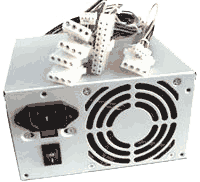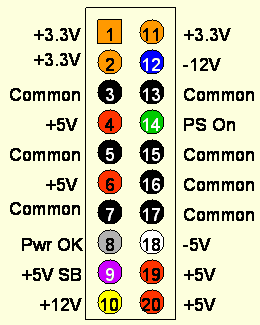 |
Here's some information
on using an ATX computer power supply. The ATX is the most common supply
out there and is in use in most desktop computers today. This is just
general information to help you get started. Not all power supplies are
identical. Individual power supply specifications are usually listed on
the case. Additional information can be obtained by doing a search for "ATX power supply" on the web. Here's a link to one site with a lot of good info. |
| The diagram at right
shows the main output connector of the power supply when viewed from the
end. The colors represent the different colored wires going into it. Common
colors represent common functions, ie all red wires are +5 volts, all
black wires are common and so on. The connections most useful to us as
haunters are the +5V (red wires) , +12V (yellow wire) and the Common or
ground (black wires). Both 5 and 12 volt lines normally deliver ample
current for our needs. Of the other voltages available, the +3.3V connection delivers ample current, it's just not a very useful voltage. The +5VSB (5 volts, always on), -12V and -5V are normally very low current lines and are of little use to us. The green wire, pin 14, is the on/off switching line. To turn the power supply on, the green line needs to be shorted to a Common line. An easy way to do this is to insert a jumper between pin 14 and pin 13. Most power supplies require a load across one or more of the outputs to operate. The link I give above shows how to add a resistor across the 5 volt side of the supply to act as a load. The smaller connectors coming out of the power supply use the same color codes. As an example, a connector with a yellow, a red and two black wires will have +12 volts (yellow), +5 volts (red) and two commons. To use the power supply, for 12 volts, you'd connect a yellow wire to the + input of your project and a black wire to the - input. For 5 volts, you connect a red wire to the + and a black wire to the -. |
 |
